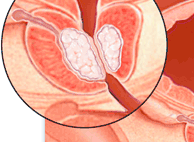Visit and Join the WeHeal Benign Prostate Hyperplasia
For more information, see: WebMD | Wikipedia

Benign prostatic hyperplasia (BPH), also called benign enlargement of the prostate (BEP or BPE), adenofibromyomatous hyperplasia and benign prostatic hypertrophy (technically incorrect usage), is a benign increase in size of the prostate.
BPH involves hyperplasia of prostatic stromal and epithelial cells, resulting in the formation of large, fairly discrete nodules in the transition zone of the prostate.[1] When sufficiently large, the nodules impinge on the urethra and increase resistance to flow of urine from the bladder. This is commonly referred to as “obstruction,” although the urethral lumen is no less patent, only compressed. Resistance to urine flow requires the bladder to work harder during voiding, possibly leading to progressive hypertrophy, instability, or weakness (atony) of the bladder muscle. Although prostate specific antigen levels may be elevated in these patients because of increased organ volume and inflammation due to urinary tract infections, BPH does not lead to cancer or increase the risk of cancer.
BPH involves hyperplasia (an increase in the number of cells) rather than hypertrophy (a growth in the size of individual cells), but the two terms are often used interchangeably, even amongst urologists.
Adenomatous prostatic growth is believed to begin at approximately age 30 years. An estimated 50% of men have histologic evidence of BPH by age 50 years and 75% by age 80 years; in 40–50% of these men, BPH becomes clinically significant.[4] BPH was one of the ten most prominent and costly diseases in men older than 50 years of age in a study in the United States.
Visit and Join the WeHeal Benign Prostate Hyperplasia
For more information, see: WebMD | Wikipedia
WeHeal is very grateful to our valued sources of information which include Wikipedia, WebMD, ClinicalTrials.gov, Cancer.gov, Infoplease, and the US CDC (Center for Disease Control).